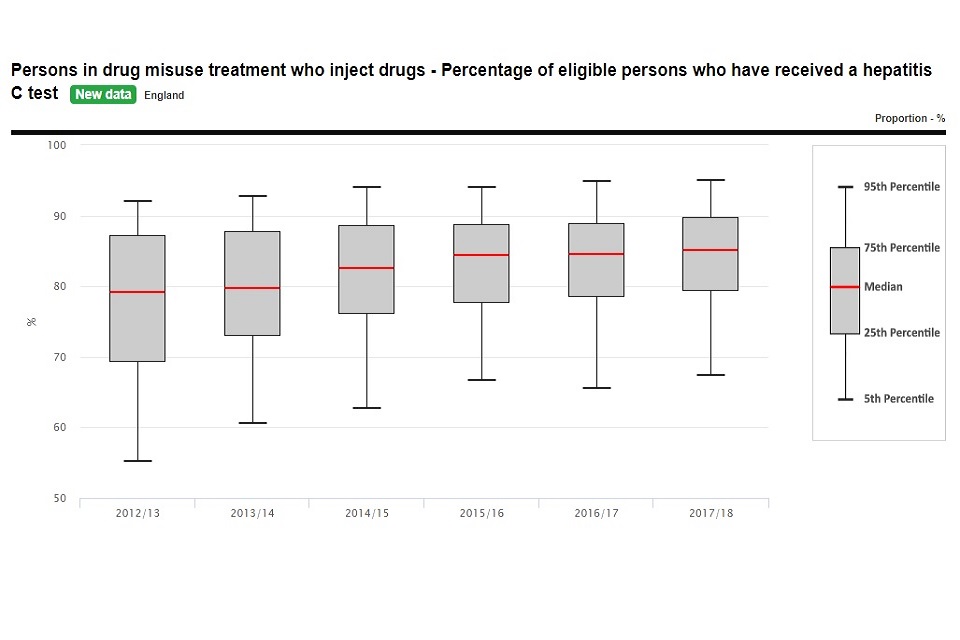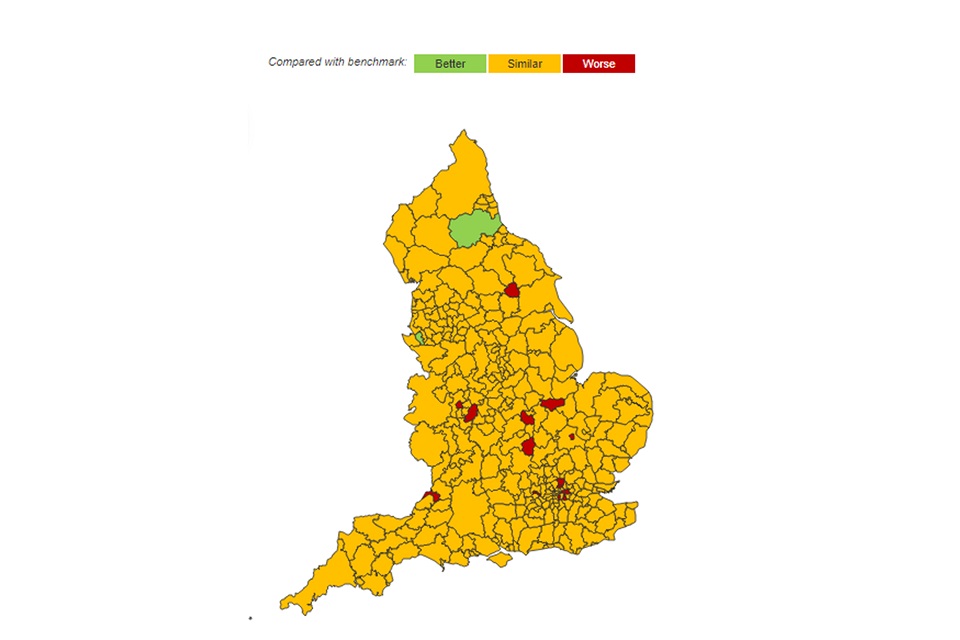Liver disease profiles: statistical commentary, April 2019
Published 2 April 2019
New in this update
This update includes new data for 2 existing indicators in the liver disease profile:
-
percentage of persons who have received a hepatitis C test among those in drug misuse treatment who inject drugs, aged over 18 years, for the financial year ending 2018
-
acute hepatitis B incidence rate per 100,000 persons, all ages, for the calendar year 2017
The indicators are available for geographies of local councils, Government Office regions (GORs) and England.
Main findings
This update shows:
-
the proportion of eligible people who received a hepatitis C test in the financial year ending 2018 in England is not significantly different to previous years
-
there is a 1.8-fold variation in the proportion of persons that were eligible and received a hepatitis C test, between local council areas across England
-
the variability of the proportion of eligible people receiving a hepatitis C test amongst UTLAs is not affected by deprivation
-
approximately 450 people are newly diagnosed with acute hepatitis B each year
Summary
Eligible people who receive a hepatitis C test
This indicator has been updated and now presents data for the financial years between 2012 to 2013, to 2017 to 2018 for eligible persons aged 18 years and over in drug misuse treatment who inject drugs and received a hepatitis C test. Persons who inject drugs are at higher risk of contracting hepatitis C infections so preventing liver disease by treating hepatitis C in at risk populations is important.
In the financial year ending 2018 the proportion of eligible people receiving a hepatitis C test was 84.2% in England. This represents 74,596 people. The England proportion has remained akin to previous years (Figure 1).
Figure 1: Proportion of eligible persons who received a hepatitis C test, England, from 2012 to 2013 to 2017 to 2018

Across the local councils, the proportion of eligible people who received a test for hepatitis C varied from the lowest 53% in Bracknell Forest to 97% in Bristol. Lancashire had the largest number (1,963) of people tested 2017 to 2018. The same proportion of eligible people in drug misuse treatment receive a hepatitis C test across all deprivation deciles (Figure 2).
Figure 2: Percentage of persons in drug misuse treatment who inject drugs and have received a hepatitis C test, 2015 to 2017 in relation to deprivation, England

Acute hepatitis B incidence rate
This indicator has been updated with 2017 data for persons. There are only two years of data currently available.
In 2017 the incidence rate for acute hepatitis B in England was 0.80 per 100,000 population. In 2016 it was 0.82. The represents 445 people were newly diagnosed with hepatitis B in 2017 across England. In 2016 there was 453 people diagnosed.
Across the local council areas, the highest rate of acute hepatitis B incidence was 4.03 per 100,000 population in Slough. Birmingham LTLA had the highest actual number (18) of people who were diagnosed with acute hepatitis B in 2017 though in 2016 they only had 4 people diagnosed.
The median rate in both 2016 and 2017 remained the same at 0.36 per 100,000 population. 43 LTLAs reported 0 new cases (Figure 3).
Figure 3: Acute hepatitis B incidence rate, per 100,000 population, England, 2017

Background and further information
Liver disease is almost entirely preventable with the major risk factors: alcohol, obesity and hepatitis B and C accounting for up to 90% of cases.
The liver disease profiles provide an invaluable resource relating to one of the main causes of premature mortality nationally; a disease whose mortality rates are increasing in England, while decreasing in most EU countries. The local authority profiles will support the development of Joint Strategic Needs Assessments and work of health and wellbeing boards presenting local key statistics and highlighting questions to ask locally about current action to prevent liver disease.
The website contains data for upper tier local authorities, former Government Office regions, England and, where available, lower tier local authorities.
The profiles, aimed at primarily LAPH were developed following recommendations in March 2014 from the All-Party Parliamentary Hepatology Group (APPHG) inquiry into improving outcomes in liver disease. Recommendations the LA profiles aim to address were:
- PHE should address the worrying lack of data on all aspects of liver disease by developing a dataset to allow performance management of liver disease across CCGs, local authorities and health and wellbeing boards
- health and wellbeing boards should monitor early detection, treatment and mortality rates from liver disease
- assessing progress on tackling liver disease should be made a mandatory part of the joint strategic planning process for CCGs and local authorities
Further details about the profile methodology are available within the definitions section of the online version of the liver disease profile.
Responsible statistician, product lead: Liz Rolfe, Julia Verne
For queries relating to this document, contact: [email protected]
